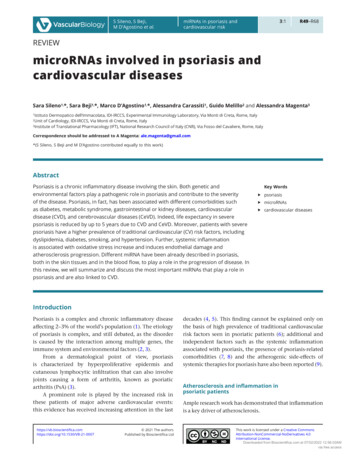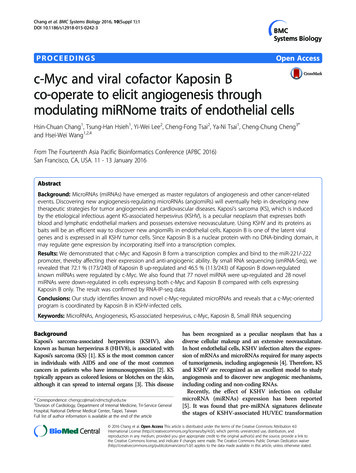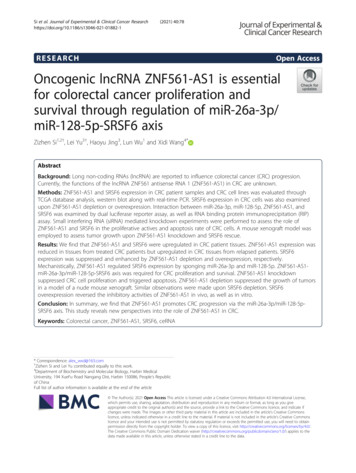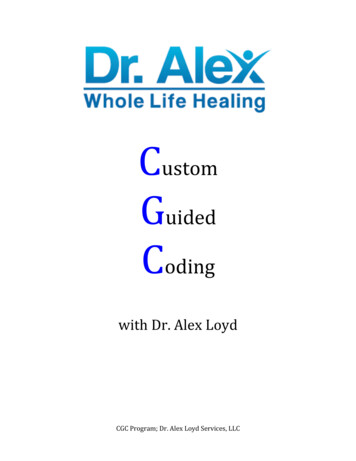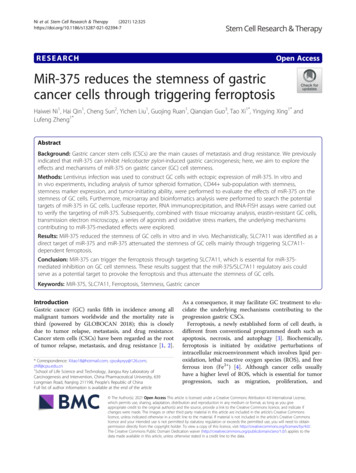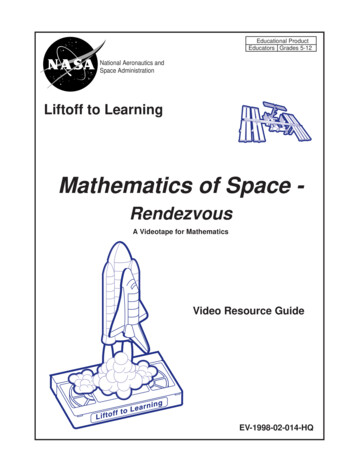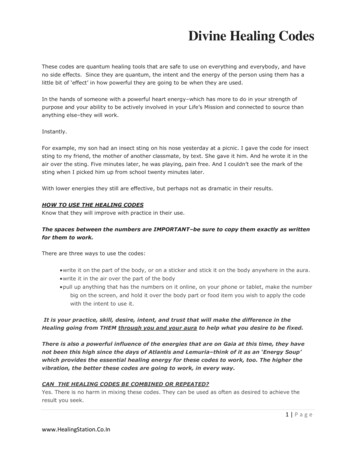
Transcription
Exosomes from Human Umbilical CordMesenchymal Stem Cells Facilitate Diabetic WoundHealing through miR-221-3p-mediatedEnhancement of AngiogenesisQian WeiMedical School of Chinese PLA: Chinese PLA General HospitalYaxi WangMedical School of Chinese PLA: Chinese PLA General HospitalKui MaFourth Medical Center of PLA General HospitalXiaowei BianFourth Medical Center of PLA General HospitalQiankun LiFourth Medical Center of PLA General HospitalBingmin LiFourth Medical Center of PLA General HospitalWenzhi HuFourth Medical Center of PLA General HospitalHaihong LiHubei University of MedicineXiaobing FuFourth Medical Center of PLA General HospitalCuiping Zhang ( zcp666666@sohu.com )Forth Medical Center of General Hospital of PLA rds: Diabetic wounds, Mesenchymal stem cells, Exosomes, MiR-221-3p/PTEN/AKT/HIF-1α/VEGFpathway, AngiogenesisPosted Date: February 3rd, 2021DOI: https://doi.org/10.21203/rs.3.rs-158498/v1Page 1/35
License: This work is licensed under a Creative Commons Attribution 4.0 International License.Read Full LicensePage 2/35
AbstractBackground: Endothelial dysfunction caused by persistent hyperglycemia in diabetes is responsible forimpaired angiogenesis in diabetic wounds. Exosomes are considered potential therapeutic tools topromote diabetic wound healing. The aim of this study was to investigate the effects of exosomessecreted by human umbilical cord mesenchymal stem cells (hucMSC-Exos) on angiogenesis under highglucose (HG) conditions in vivo and in vitro and to explore the underlying mechanisms.Methods: HucMSC-Exos were used to treat diabetic wounds and human umbilical vascular endothelialcells (HUVECs) exposed to HG. Wound healing and angiogenesis were assessed in vivo. The biologicalcharacteristics of HUVECs were examined in vitro. Expression of pro-angiogenesis genes in HUVECs wasalso examined by western blotting. The miRNAs contained within hucMSC-Exos were identified usingmiRNA microarrays and qRT-PCR. The roles of selected miRNAs in angiogenesis were assessed usingspecific agomirs and inhibitors.Results: In vivo, local application of hucMSC-Exos enhanced wound healing and angiogenesis. In vitro,hucMSC-Exos reduced senescence of HG-treated HUVECs and promoted proliferation, migration, and tubeformation by inhibiting phosphatase and tensin homolog (PTEN) expression and activating the AKT/HIF1α/VEGF pathways. MiR-221-3p was enriched in hucMSC-Exos. In vitro, MiR-221-3p downregulated PTENand activated the AKT/HIF-1α/VEGF pathway to promote proliferation, migration, and tube formation inHG-treated HUVECs. In vivo, miR-221-3p agomirs mimicked the effects of hucMSC-Exos on woundhealing and angiogenesis, whereas miR-221-3p inhibitors reversed their effects.Conclusions: Our findings suggest that hucMSC-Exos have regenerative and protective effects on HGinduced senescence in endothelial cells via transfer of miR-221-3p, thereby accelerating diabetic woundhealing. Thus, hucMSC-Exos may be promising therapeutic candidates for improving diabetic woundangiogenesis.IntroductionDiabetes is a multifaceted metabolic disorder. Nearly 20% of diabetics worldwide develop prolongedwounds, which may lead to the formation of skin ulceration [1]. Leg and foot ulcers are the most commontypes of diabetic wounds. Diabetic foot ulceration results in amputation in 15–27% of patients if notproperly diagnosed and treated [2]. Despite improvements in wound repair, cure of chronic diabeticwounds remains a distant goal because of impaired healing. Angiogenesis plays a critical role in thewound healing process, facilitating the transport of nutrients and oxygen to lesion sites and enhancingfibroblasts multiplication, collagen synthesis and re-epithelization [3, 4]. Hypo-vascularization isassociated with delayed or dysfunctional healing of diabetic wounds [5, 6]. Furthermore, hyperglycemia, atypical characteristic of diabetes, is commonly associated with refractory wounds and endothelialmalfunction, which, in turn, lead to vascular complications such as diabetic foot ulceration [7].Page 3/35
Accordingly, novel remedies to promote angiogenesis would be highly valuable for managing diabeticwounds.Mesenchymal stem cells (MSCs) have been shown to promote angiogenesis in ischemic conditions suchas chronic wounds [8–10], myocardial infarction [11, 12], and cerebral ischemia [13, 14]. For example,human umbilical cord MSCs (hucMSCs) relieved hind limb ischemia by promoting angiogenesis in mice[15]. Recently, promotion of angiogenesis by MSCs has increasingly been attributed to exocrine factors[16, 17]. Exosomes carry molecules including proteins, mRNAs, and miRNAs, and have beendemonstrated to act as paracrine factors to regulate the interactions between MSCs and target cells.Compared with their parental MSCs, exosomes have several advantages including high stability,increased therapeutic efficiency and safety, absence of immune reactions, fewer ethical issues, anddecreased potential for embolism formation and carcinogenicity [18–21]. Exosomes derived from manysources of MSCs have been reported to promote angiogenesis and represent promising treatment optionsfor diabetic wounds. For instance, exosomes derived from bone marrow MSCs facilitated diabetic woundrepair by increasing angiogenesis via the AKT/eNOS pathway [22]. Exosomes derived from hucMSCs(hucMSC-Exos) and lipopolysaccharide-preconditioned hucMSC-Exos regulated macrophage plasticity toresolve chronic inflammation during diabetic wound healing [23]. However, whether hucMSC-Exos canrestore the proangiogenic ability of endothelial cells injured under high glucose (HG) conditions remainsto be confirmed.Exosomes contain multiple types of information-containing molecules including miRNAs, non-codingsmall RNAs that can bind to the 3′- untranslated region of mRNAs to inhibit target gene expression.Exosomal miRNAs have important regulatory functions and may participate in wound healing andangiogenesis. For example, exosomes derived from human adipose-derived MSCs transferred miRNA125a to endothelial cells and promoted angiogenesis in vivo and in vitro by repressing Delta-like 4expression [24]. Circulating exosomes containing miR-20b-5p isolated from diabetic patients slowedwound healing and angiogenesis by targeting Wnt9b/β-catenin signaling [25]. Recently, hucMSC-Exoscombined with pluronic F127 hydrogel were reported to have beneficial effects for diabetic woundtreatment [26], but the mechanisms through which hucMSC-Exos exert their functions remain unclear.In this study, we first assessed the effects of hucMSC-Exos on diabetic wound healing and angiogenesis.We used hucMSC-Exos to treat human umbilical vascular endothelial cells (HUVECs) exposed to HG.Subsequently, the proliferation, migration, tube formation, and senescence of HUVECs were examined.Expression of angiogenesis-related proteins including phosphatase and tensin homolog (PTEN), p-AKT,hypoxia inducible factor (HIF)-1α, and vascular endothelial growth factor (VEGF) was assessed. We alsoidentified candidate miRNAs in hucMSC-Exos and showed that these could improve endothelial cellfunction and target the PTEN/AKT/HIF-1α/VEGF pathways.MethodsCulture and identification of hucMSCsPage 4/35
The hucMSCs (P1) were acquired from the Chinese Academy of Sciences' cell bank and cultured inDulbecco’s modified Eagle's medium/F12 (DMEM/F12, Gibco, USA), containing 10% Fetal Bovine Serum(Gibco, USA) and 1% penicillin and streptomycin (Gibco, USA). The flow cytometer was employed todetermine cell surface markers of hucMSCs. The hucMSCs were washed and co-incubated withfluorescence-conjugated antibodies (Abcam, USA) (CD73-PE, CD90-FITC, CD105-FITC, CD45-FITC, CD19FITC, HLA-DR-FITC and CD34FITC) at room temperature for three quarters of an hour. To identify themulti-differentiation potential, hucMSCs were incubated with chondrogenic, adipogenic and osteogenicdifferentiation medium (Cyagen, China), respectively. Next, these induced cells were stained severally withAlcian blue, Oil Red O, and Alizarin Red S to evaluate chondrogenic, adipogenic, and osteogenicdifferentiation. Then these cell images were filmed with an Olympus IX71 light microscope (Olympus,Japan).Isolation and characteristics of hucMSC-ExosAfter 2–3 passages, the culture medium of hucMSCs was changed into DMEM/F12 containing 10%exosome-free FBS (SBI, USA). The cultured supernatant of hucMSCs was collected every 72h startingfrom passage 3 until passage 7. Exosomes were harvested from supernatant by means of a series ofultra-high-speed centrifugation procedures according to the protocol illustrated by Jia et al [27] . Thecharacteristics of hucMSC-Exos were conducted by nanoparticle tracking analyzer (NTA) (Particle MetrixGmbH, Germany) and transmission electron microscope (TEM) (Hitachi, Japan). Expressions of thehucMSC-Exos markers containing CD81, CD63, CD9, the tumor susceptibility gene101 (TSG101), wereexamined by Western blot.In vivo administration of hucMSC-ExosAll animal procedures involved were approved by the Animal Research Committee of PLA GeneralHospital in Beijing, China and were conducted in accordance with the principles and procedures of theNational Institutes of Health (NIH) Guide for the Care and Use of Laboratory Animals. Remarkable effortswere made to minimize the number of animals and their sufferings. Thirty male diabetic mice of 8 weeks(BKS-Dock Leprem2Cd479, db/db), weighing about 35 g, were anesthetized with 4% chloral hydrate. Fullthickness skin wounds of 18mm in diameter were created on the backs of diabetic mice. Afterward, allmice were randomly divided into exosome groups (7, 14, and 21 days) and control groups (7, 14, and 21days). There were five mice for each time point. HucMSC-Exos (100mL, 200 ug/mL) and PBS (100 mL)were injected around the wounds at 4 sites (25 μL per site) with a micro syringe (Hamilton) at every otherday.Wound closure evaluation and neovascularizationobservationPage 5/35
Wounds from each group were imaged at 0, 7, 14 and 21 days post-wounding. All wounds werecalculated with a caliper ruler and areas of them were evaluated in Image -Pro Plus software (MediaCybernetics, USA). The wound closing rate was calculated as the following formula: (A0 - At) / A0 100%.A0 represents the primary wound area and At represents the wound area at 7, 14 and 21 days. To detectthe generation of new blood vessels, the skin underside at day 21 was observed and captured using adigital camera and a microscope at 2.5 magnification. Percentage of vessel area was measured aspreviously described [22].Histological analysis and immunohistochemistryAfter the mice were put to euthanasia by being excessively injected with pentobarbital, wound sites wereobtained and fixed postoperatively. The obtained tissues were dehydrated step and step and embedded inparaffin. Subsequently, these embedded tissues were cut into 5 μm thick sections and stained withhematoxylin and eosin (H&E). Measurement of scar width and neo-epithelium percentage was performedas previously described [28]. Masson's trichrome was stained to assess the extent of collagen maturity.Collagen volume fraction were quantified according to literature previously described [29].Immunohistochemistry staining for CD31 (Abcam, the USA, ab28364, 1:100) was conducted to examinethe degree of newly-formed capillaries in wound sites. Briefly, the paraffin sections were incubated withthe primary CD31 antibody overnight at 4 C and then with the secondary HRP-conjugated antibody(1:200, Abcam) for 1 h at room temperature. Finally, the sections were colored by a DAB kit (ZSGB-BIO,China). Images were photographed under a microscope and measured as literature previously described[30].Blood perfusion evaluationOn day 21 postoperation, we applied laser speckle contrast imaging (LSCI) to investigate the woundperfusion. A PeriCam PSI-ZR (PERIMED Ltd, Sweden) was employed to record images of each wound. Aunit of perfusion was detected based on a near-infrared laser (785 nm) for perfusion measurements.Images were captured using the same scan site dimensions at a fixed distance from the wound surface.Applying PIMSoft (Moor Instruments Ltd, UK), flux photographs of each wound were estimated toevaluate the mean perfusion units (MPUs) ratio calculated by comparing the MPUs at the wound site(ROI-1) with that of the area besides the wound (ROI-2).Cell culture and hucMSC-Exo uptakeHUVECs were obtained from the Chinese Academy of Sciences (Shanghai, China). These cells wereincubated in Dulbecco's modified Eagle's medium (DMEM, Gibco, USA) consisting of 10% fetal bovineserum (Gibco, USA) and 1% penicillinstreptomycin. The normal glucose (NG) concentration is 5.5 mM. ToPage 6/35
examine hucMSC-Exo uptake by HUVECs, exosomes were labeled with PKH67 (Sigma-Aldrich, Germany),a green fluorescent dye, in the light of the manufacturer’s protocol. Then, HUVECs were co-cultured withPKH67-labeled exosomes for 4.5 h and next fixed in 4% paraformaldehyde for 15min. After these cellswere washed by PBS, HUVECs were incubated with CD31 antibody (1:100) overnight at 4 C. Next Cy3conjugated secondary antibody (Abcam, 1:500) and DPAI (Sigma-Aldrich, 2 mg/mL) were applied for theincubation for visualization. At last, HUVECs were observed via a confocal microscope (Leica, Germany).Proliferation and cell cycle assayFor proliferation assay, HUVECs (8 103 cells per well) were seeded into 96-well plates. The cells incontrol group were cultured in NG concentration and those in HG group were incubated with glucoseconcentration of 35 mM. Different concentrations of exosomes (50, 100, 150, 200 μg/mL) were added tothe culture medium of HG-induced HUVECs to select the optimal concentration. On day 1, 3, 5 and 7, cellcounting kit-8 (CCK-8, 10 μL per well, Dojindo Molecular Technologies, Japan) was added to the medium(100 μL per well). The absorbance of per well was examined at 450nm by an enzyme immunoassayanalyzer (Bio-Rad 680, Hercules, USA) after incubation for 3 h at 37 C. According to the results of CCK-8assay, the optimal concentration of exosomes, which had the most obvious effect on cell viability, waschosen to applied in the following experiments including cell cycle, cell migration, tube formation, andcellular senescence assays. Additionally, the expression of PTEN, p-AKT, AKT, HIF-1α, and VEGF wasevaluated by Western blot.For cell cycle assay, HUVECs (8 105 cells per well) were seeded in six-well plates and cultured in NG, HGand HG Exos. After being cultured for 3 days, the cells were harvested from six-well plates and fixedwith 70% cold ethanol overnight at 4 C. On the second day, single cell suspensions were put intodigestion with 100 μl/well DNase-free RNase in incubator at 37 C, and subsequently 400 μl of propidiumiodide (PI) solution was added for DNA staining for 1 h at 4 C. PI fluorescence as well as forward lightscattering was examined with a flow cytometer (BD FACS Calibur , Becton-Dickinson, USA). The percentof cells in different phases was calculated.Cell migration assayThe migration property of HUVECs was evaluated by means of scratch and transwell assay. For scratchassay, HUVECs were cultured in six-well plates. When 90% confluence was reached, cells were scratchedwith a pipette tip. At planned time point, cells were photographed using a microscope. Distances betweentwo borders of the scratch were calculated by ImageJ software. The migration rate (%) was calculated as:(M0 Mt) / M0 100%, in which M0 stood for the initial scratch distances, while Mt represented theresting scratch distances at the surveyed time point. For transwell assay, approximate 0.5 104 HUVECswere suspended in serum-free medium and seeded into the upper chamber of 24-well plates (Corning)with 8.0 μm polycarbonate membrane. Then the complete medium (containing serum) supplementedPage 7/35
with HG or Exos was added into the lower chamber. After 24 h, we swabbed the cells on the upper surfaceof the filter membranes and the migrated cells on the lower surface were stained with crystal violet(Solarbio, 0.1%, w/v) for 7 min. The stained cells were observed and calculated under an opticalmicroscope.Tube formation assay50μl cold Matrigel was added into each well of a pre-cooling 96-well plate and next incubated at 37 for30 min. HUVECs (2 104 cells per well, five replicates per group) were put into the Matrigel-coated platesand treated with different mediums (NG, HG and HG Exos). After incubation for 6 h at 37 , tubeformation was examined under a microscope. The parameters (total branching points and total tubelength) demonstrating the tube formation capability were measured with Image-Pro Plus 6.0 software.Cellular senescence assayReactive oxygen species (ROS) measurement, SA-β-gal staining and the detection of age-related genesincluding p21, p16 and p53 were performed to evaluate cellular senescence. After cultured under designconditions (NG, HG and HG Exos), HUVECs were incubated with 10 μM 2′,7′-dichlorodihydrofluoresceindiacetate (DCFDA, Sigma-Aldrich, Germany). The accumulation of ROS in cells was quantified using flowcytometer (BD FACS Calibur , Becton-Dickinson, USA). SA-β-gal staining was conducted with a SA-β-galstaining kit in accordance with the manufacturer's protocols. Briefly, HUVECs were washed three timeswith PBS and then fixed with 4% paraformaldehyde for 30min. After incubated with staining solutionovernight under 37 C CO2-free condition, the cells were observed with a microscope. The ratio of SA-β-galpositive cells was calculated by counting blue cells versus total cells. The expression of age-related geneswas performed by Western blot.PTEN siRNA interferenceTo assess whether the knocking down of PTEN expression can achieve the similar effects of hucMSCExos on HG-induced HUVECs, PTEN siRNAs were obtained from RiboBio (Guangzhou, China) and used toknock down the expression of PTEN in HUVECs. Briefly, HG-induced HUVECs were transfected withsiRNAs or the universal negative control siRNA (Con siRNA) using Lipofectamine 2000 according to themanufacturer’s instructions. After 24 h, the expression of PTEN was detected by qRT-PCR to evaluate theinhibitory efficiency of siRNAs. In addition, the proliferation of HUVECs was evaluated by CCK-8 at day 1,3, 5 and 7. Then we performed the downstream experiments including scratch, transwell, and tubeformation assays (the methods are the same as above).Detection of miRNAs in hucMSC-ExosPage 8/35
MiRNA microarray and qRT-PCR were perform to find the candidate exosomal miRNAs which play animportant role in hucMSC-Exos-induced effects. MiRNAs in exosomes were isolated via the use of theSeraMir Exosome RNA Purification Kit (System Biosciences, Mountain View, USA). MiRNA microarray wasconducted using GeneChip miRNA 4.0 array which contains 30424 probe sets covering 2578 humanmiRNAs, 728 rat miRNAs, and 1908 mouse miRNAs. The miRNAs highly expressed in hucMSC-Exos werefurther confirmed by qRT-PCR. Bioinformatics analysis was conducted by programs including Targetscan(http://www.targetscan.org/), miRanda (http://www.microrna.org), and Pictar (http://pictar.mdcberlin.de/). According to the results of miRNA detection and bioinformatics analysis, miR-221-3p wasfound to be the most highly expressed miRNA and target PTEN. Next, the potential role of miR-221-3p inhucMSC-Exos was explored.MiRNA interferenceWe obtained miR-221-3p inhibitors, negative control (NC) inhibitors, miR-221-3p agomirs, and negativecontrol agomirs from GenePharma (Suzhou, China). To produce exosomes without miR-221-3p, miR-2213p inhibitors or NC inhibitors (100 nmol/L) were transfected into hucMSCs which have grown to 80%confluence with aid of Lipofectamine 2000 (Invitrogen, NY, USA). After 6 h, the transfected cells weremaintained in the medium containing Exos-free FBS for 48 h. Exosomes were isolated from theconditioned medium of the cells transfected with miR-221-3p inhibitor or NC inhibitor. These exosomeswere named as Exos-inhibitor miR-221-3p (exosomes without miR-221-3p) and Exos-inhibitorNC,respectively. Next, HG-treated HUVECs were incubated with Exos-inhibitor miR-221-3p or Exos-inhibitorNC, ortransfected with miR-221-3p agomirs or NC agomirs. The expressions of miR-221-3p and PTEN inHUVECs from different groups were detected by qRT-PCR. We also observed the expressions of PTEN, pAKT, AKT, HIF-1α, and VEGF by Western blot. The proliferation, migration and tube formation abilities wereinvestigated by the methods described above. Additionally, animal experiment with mice was alsoperformed to evaluate the potential role of miR-221-3p in hucMSC-Exos. The experiment designs thegroups as in the cellular experiments. Wound closure, blood perfusion and angiogenesis were examinedby the methods in above animal experiment.Western blotThe total protein was harvested using RIPA buffer with a protease phosphatase inhibitor mixture(Solarbio, China). 10% SDS-PAGE was employed to separate proteins. The PVDF membrane (Millipore)was utilized to blot the proteins. Skimmed milk was applied to block the membranes for 1 h. Next, thePVDF membranes were incubated with primary antibodies including anti-CD81, anti-CD63, anti-TSG101,anti-CD9, anti-p21, anti-p53, anti-p16, anti-AKT, anti-phosphorylate AKT (anti-p-AKT), anti-PTEN, antiHIF1α, and anti-VEGF (Abcam, USA) at 4 C overnight followed by being treated with horseradishperoxidase-conjugated (HRP)-linked secondary antibodies (ZSGB-BIO, China) for 1 h at room temperatureon the next day. The immunoreactive bands were visualized via an ECL kit (Solarbio, China) and imagedPage 9/35
by UVITEC Alliance MINI HD9 system (UVITEC, Britain). The protein expression level was quantified byImageJ.qRT-PCR analysisTotal RNA was extracted from HUVECs with Trizol Reagent (Invitrogen, USA) and cDNA was synthetizedout of 1μg of total RNA by employing the Revert Aid first-strand cDNA synthesis kit (Fermentas, LifeSciences, Canada). Next, qRT-PCR was conducted with an ABI PRISM 7900HT System with SYBRPremix ExTaqTM II (Takara Biotechnology, Japan). GAPDH was applied to normalize the results. Primersequences used for qRT-PCR were seen in Table S1. For detection of miRNAs, exosomal miRNAs wereisolated via the use of the SeraMir Exosome RNA Purification Kit (System Biosciences, Mountain View,USA), and cDNA for miRNAs was integrated with TaqMan microRNA assay kit (Applied Biosystems,Foster City, USA) according to the manufacturer’s protocol. The qRT-PCR reaction was conducted usingFastStart Universal SYBR Green Master Mix (Roche, Indianapolis, USA) with the miRNA-specific forwardprimer (Yanzai Biotech, Shanghai, China; Table S1) and the universal reverse primer produced by theTaqMan miRNA assay kit. U6 small nuclear RNA was for normalization.Statistical analysisAll data were reported as mean standard deviation (SD) and evaluated with analysis of variance(ANOVA) and Student t test where appropriate. All experiments were carried out at least three times.Differences were considered to be statistically significant when p 0.05.ResultsHucMSC-Exos enhance cutaneous wound healing indiabetic miceHucMSCs were cultured and identified based on their morphology, phenotype, and function (Figure S1).Exosomes were isolated from hucMSCs and characterized by NTA, TEM and western blotting. NTAshowed that the sizes of hucMSC-Exos ranged from 60 nm to 180 nm (mean diameter 100 nm), whereasthe concentration of exosomes was 8.77 109 particles/mL (Fig. 1A). TEM revealed that hucMSC-Exoshad a “saucer-like” ultrastructure (Fig. 1B). Representative exosomal markers including TSG101, CD63,CD9 and CD81 were expressed by the hucMSC-Exos (Fig. 1C). These results, which were consistent withthose of previous reports [31-33], demonstrated that the isolated nanoparticles were indeed exosomes.To evaluate the effects of hucMSC-Exos on diabetic wound healing, we created full-thickness cutaneouswounds on the backs of diabetic mice and injected hucMSC-Exos or phosphate-buffered saline (PBS)around the wounds. Digital photographs of the wound sites taken at day 0, 7, 14, and 21 showed theprogress of wound closure in different groups of mice. Gross observations showed that the hucMSC-ExoPage 10/35
treated mice had reduced wound areas at days 7, 14, and 21 compared with PBS-treated control mice(Fig. 1D). The wounds of hucMSC-Exo-treated mice had mostly recovered at day 21, whereas scar areasremained discernable in the control mice. The dimensions of the wound areas were measured 0, 7, 14,and 21 days after wounding. As shown in Fig. 1E, the extent of wound healing in hucMSC-Exo-treatedmice was significantly greater after 7, 14, and 21 days than that in control mice (p 0.001). At 21 daysafter wounding, wounds in hucMSC-Exo-treated mice were completely healed, whereas those of controlmice still had approximately 40% of their area remaining to be closed. Rapid reepithelialization is one ofthe key steps in wound healing. Consistent with the wound area observations, hematoxylin and eosinstaining showed that hucMSC-Exo-treated wounds had longer neo-epidermis and dermis lengths thanthose of PBS-treated wounds at day 7, 14 and 21 post-wounding (Fig. 1F). Furthermore, quantitation ofre-epithelialization rates and scar widths showed that hucMSC-Exo treatment facilitated epidermalregeneration and diminished scar formation at wound sites (Fig. S2). Masson staining also revealed agreater number of wavy fibers in exosome-treated wounds compared with control wounds (Fig. 1G). Atthe end 21 days, the collagen volume fractions of exosome-treated and control wounds were 70.13 5.76% vs. 43.20 7.70 % (p 0.001). These data suggested that hucMSC-Exo treatment can promote woundhealing in diabetic mice.HucMSC-Exos promote angiogenesis in the wound sites ofdiabetic miceWe next assessed whether treatment with hucMSC-Exos could promote angiogenesis at wound sites,thereby enhancing diabetic wound healing. As shown in Fig. 2A, larger amounts of newly formed bloodvessels were observed in hucMSC-Exo-treated wounds at day 21 post-wounding compared with PBStreated wounds. The percentage vessel area in hucMSC-Exo-treated wounds was significantly higher thanthat in PBS-treated wounds (41.01 2.43 % vs. 20.01 7.96 %; p 0.001) (Fig. 2B). The blood flow atwound sites in different groups was evaluated by small animal doppler. Flux images of hucMSC-Exotreated wounds showed larger red areas than control wounds (Fig. 2C left), reflecting better bloodperfusion in hucMSC-Exo-treated wounds. The mean perfusion unit (MPU) ratio in hucMSC-Exo-treatedmice was also higher than that in control mice (2.57 0.44 vs. 1.64 0.24; p 0.01) (Fig. 2C right). CD31is a marker for newly formed blood vessels. Immunohistochemistry for CD31 (Fig. 2D) revealed thatnewly developed blood vessels at wound sites were increased following treatment with hucMSC-Exoscompared with controls from day 7 (0.28 0.06 vs. 0.14 0.01; p 0.05) to day 14 (0.57 0.02 vs. 0.19 0.01; p 0.001) (Fig. 2E). Collectively, these findings suggested that hucMSC-Exos can promoteangiogenesis at wound sites in diabetic mice.HucMSC-Exos improve the function of HG-treated HUVECsin vitroPage 11/35
To understand the multiple effects of hucMSC-Exos on HUVECs, we first determined whether hucMSCExos could be internalized into endothelial cells. Previous studies illustrated that adhesion molecules onthe surface of exosomes are associated with adherence to specific cells, but the cellular and molecularbases for specific targeting of recipient cells remain unclear. Therefore, we tested whether hucMSC-Exoscould be taken up by HUVECs. HucMSC-Exos were labeled with PKH67 and then incubated with HUVECs.Next, recipient HUVECs were washed with PBS to remove unbound labeled exosomes. After fixation withparaformaldehyde, recipient cells were stained with CD31 (red) and 4′,6-diamidino-2-phenylindole. Asshown in Fig. 3A, all HUVECs were stained green after incubation with labeled hucMSC-Exos for 4.5 h,demonstrating that PKH67-tagged hucMSC-Exos had been transferred to the perinuclear regions ofHUVECs.To simulate a HG microenvironment in vitro, HUVECs were treated with D-glucose at a final concentrationof 35 mM as previously described [34]. The results of a cell counting kit-8 (CCK-8) assay showed lowerproliferation of HG-treated HUVECs compared with normal glucose (NG)-treated HUVECs (Fig. 3B).Different concentrations of exosomes were added to the culture medium of HG-induced HUVECs.Treatment with hucMSC-Exos significantly enhanced the viability of HG-induced HUVECs at days 3, 5 and7 in a dose-dependent manner (Fig. S3). The 200 µg/mL concentration of hucMSC-Exos had the greatestimpact on cell viability (Fig. 3B). This result was further confirmed using a cell cycle assay. Theproportions of three cellular subpopulations (G0/G1, S and G2/M) were estimated from DNA distributionas determined by flow cytometry. HG stimulation inhibited the G1-S transition, and treatment withhucMSC-Exos partially rescued HG-induced cell cycle arrest. In HG hucMSC-Exo-treated HUVECs, morecells were in the S and G2/M phases compared with HUVECs treated with HG alone (33.30 2.98 % vs.16.55 1.89 %; p 0.0001), suggesting that hucMSC-Exos promoted entry into the proliferative phase(Fig. 3C, D). Migration of HUVECs was evaluated using wound scratch and transwell assays. Scratchassays demonstrated that the migration rates of HG-induced HUVECs were decreased significantlycompared with NG-induced HUVECs (migrating area of 24h: 37.70 2.50 % vs. 86.88 3.17 %; p 0.01).However, hucMSC-Exo stimulation improved the migration rates of HG-treated HUVECs (migrating area of24h: 65.20 3.13 % vs. 37.70 2.50 %; p 0.01) (Fig. 3E, F). Consistent with the results of the scratchassay, the number of migrated HG-treated HUVECs was less than the number of migrated NG-treatedHUVECs (147.80 8.13
Fourth Medical Center of PLA General Hospital Cuiping Zhang ( zcp666666@sohu.com ) . repair by increasing angiogenesis via the AKT/eNOS pathway [22]. Exosomes derived from hucMSCs (hucMSC-Exos) and lipopolysaccharide-preconditioned hucMSC-Exos regulated macrophage plasticity to . Exosomes contain multiple types of information-containing .
